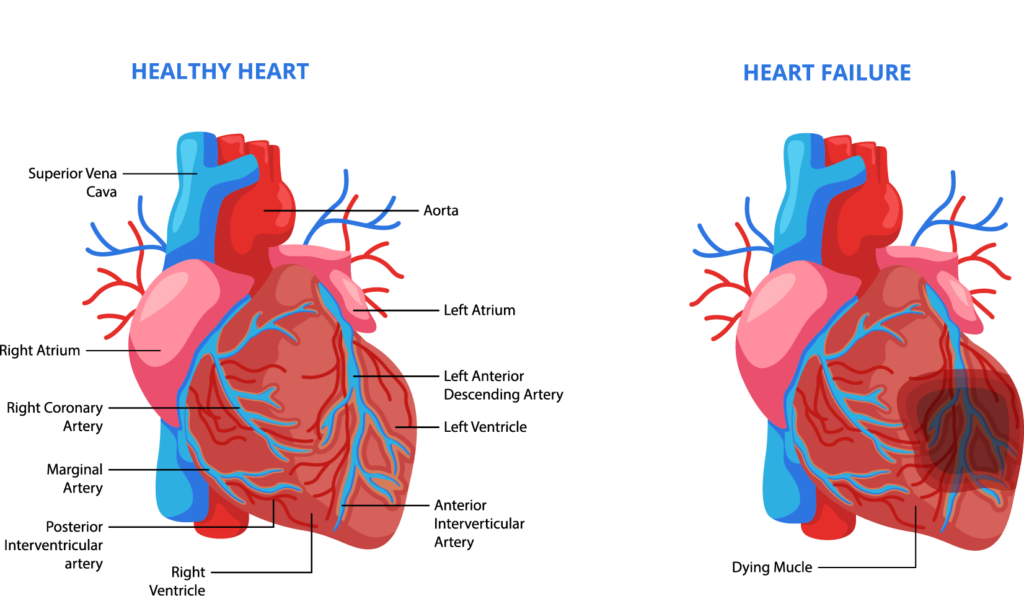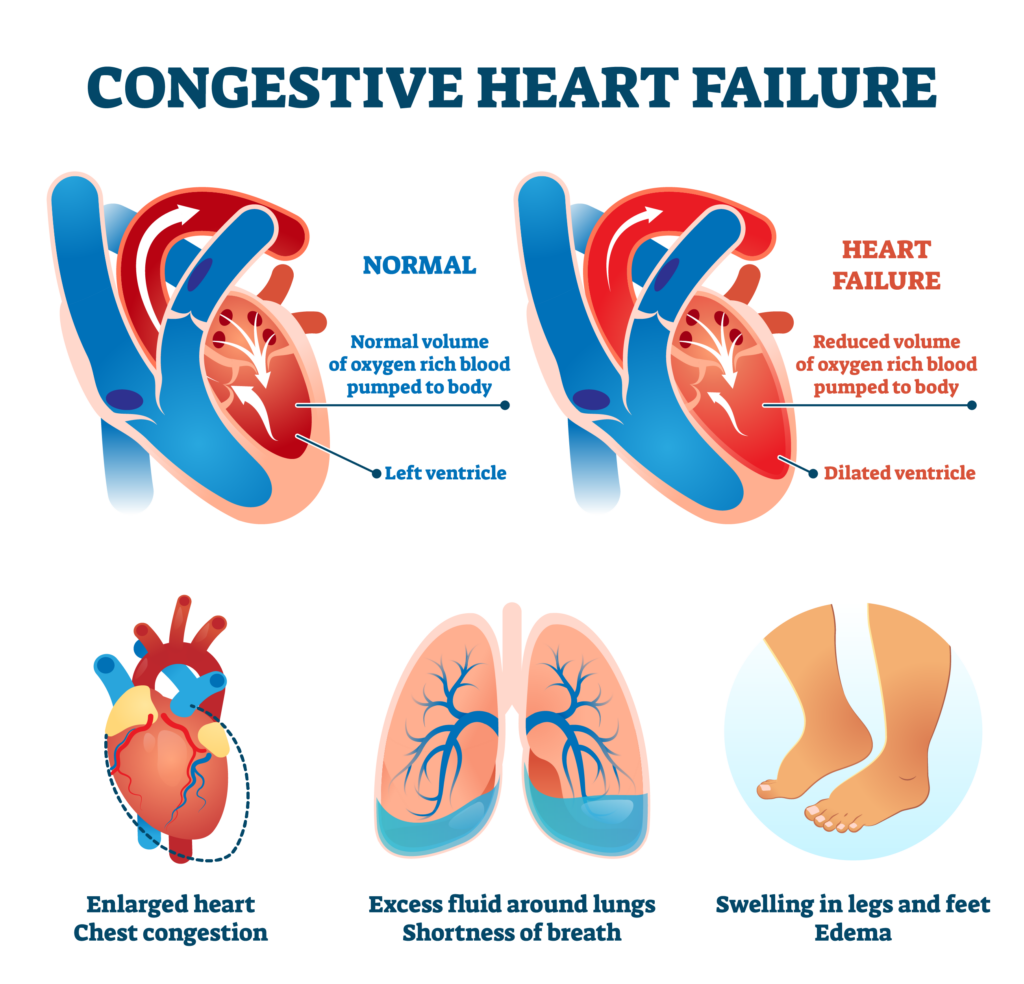Chronic systolic heart failure, commonly known as Congestive Heart Failure, is a serious medical condition that occurs when the left side of our heart fails to pump enough blood to meet the body’s basic requirements. A major cause of morbidity and mortality worldwide, it significantly burdens healthcare expenditures annually. Early recognition of systolic heart failure symptoms is crucial for diagnosis and optimal treatment outcomes.
What is Chronic Systolic Heart Failure?

The human heart is divided into left and right chambers. Each chamber is composed of an atrium and a ventricle. The right side of the heart receives deoxygenated blood from other organs, whereas the left side pumps oxygenated blood to the body.
Systolic Heart failure is a serious medical condition that occurs when the left side of our heart fails to pump enough blood to meet the body’s basic requirements. This ultimately leads to the failure of other vital organs, such as the kidneys and liver. When you develop insidious and gradual heart failure symptoms from a previously prevailing heart disease background, it’s called ‘chronic’ systolic heart failure.
Chronic systolic heart failure is a significant cause of morbidity and mortality worldwide.
The global prevalence of chronic heart failure is 64.34 million cases, per the Global Health Data Exchange registry.1Malik, A., Brito, D., Vaqar, S., & Chhabra, L. (2022). Congestive heart failure. In StatPearls [Internet]. StatPearls Publishing.
It has no definitive cure. However, early diagnosis and prompt management can help regress the worsening of the disease.
Ejection fraction:
Chronic systolic heart failure is also known as heart failure with reduced ejection fraction.
Ejection fraction (EF) is the percentage of blood circulated into the system when the left ventricle contracts, the normal value of which in a healthy person ranges between 50-70%2American Heart Association. (2017). Ejection fraction heart failure measurement. Www.heart.org; American Heart Association. https://www.heart.org/en/health-topics/heart-failure/diagnosing-heart-failure/ejection-fraction-heart-failure-measurement.
It is classified as:
- Heart failure with reduced ejection fraction (HFrEF): EF < 40%
- Heart failure with preserved ejection fraction: EF >50%
- Heart failure with mid-range ejection fraction: EF range is between 40%- 50%
Causes of Chronic Systolic Heart Failure:
Any factor that weakens the cardiac muscle and alters its structure can lead to systolic failure. We discuss some of the common causes below:
Coronary artery disease:
It is one of the commonest causes of heart failure worldwide. A build-up of atherosclerotic plaques in the lumen of arteries supplying heart muscle impedes the regular flow of blood. Consequently, this reduced blood flow leads to the death of associated muscle fiber and weakens the ventricle. The arterial lumen may also become narrowed due to the constriction of its wall.
Hypertension:
Raised pressure in the arterial lumen for prolonged periods constricts arteries elsewhere in the body. The kidneys respond to this change by conserving more water to re-establish the flow. This increases the workload on the cardiac muscles, which in turn impairs their strength. If you go on with an uncontrolled BP for several months, it can lead to congestive heart failure.
Valvular incompetence:
The inability of mitral valves to close properly during contraction can result in excessive blood pooling in the left ventricular chamber, which exerts more pressure on the cardiac muscles. This consequently weakens muscle fibers, hampering their ability to contract against blood in the lumen, giving rise to chronic systolic congestive heart failure.
Chronic Systolic Heart Failure Symptoms

Recognizing common symptoms of heart failure is crucial for early diagnosis and intervention, which can help reduce morbidity and mortality rates. As per the International Classification of Diseases (ICD) – a directory designed by the WHO to classify and code all symptoms, diagnoses, and treatments – patients with chronic systolic heart failure are classified as ICD 10 and usually present with the following signs and symptoms:
- Shortness of breath: if you are a heart patient and you start experiencing dyspnea or shortness of breath, it may be due to the back pressure of blood in pulmonary arteries caused by the pooling of blood in the left ventricle.
- Chest tightness or pain: in the background of longstanding heart failure, if you develop chest pain or tightness that is sudden in onset and progresses rapidly, you require urgent medical attention. This condition is termed acute on chronic systolic heart failure.
- Dizziness: inadequate blood flow to body organs due to systolic failure can lead to impaired perfusion of cells. If your brain doesn’t receive the required blood perfusion, you may experience dizziness or syncope.
- Edema (swelling) of limbs: the pooling of blood in the heart leads to the back pressure of fluids in the rest of the body. As a patient with chronic systolic heart failure, you might notice swelling of hands and feet that leaves an indentation upon pressing.
- Palpitations: the patient also experiences irregular heart rhythm. It happens when the cardiac muscles try to compensate for the missed heartbeat.
- Fatigue: impaired blood flow to the body’s muscles leads to generalized tiredness and fatigue.
- Coughing or wheezing: back-pressure of blood in arteries of the lungs causes the fluid to extravasate into the lung tissue, which results in wheezing and frothy cough.
Diagnosing Chronic Systolic Heart Failure
Chronic systolic heart failure is diagnosed using multiple clinical tools. Your GP will take the following steps in order to get a diagnosis.
History:
A detailed history is the first step and is important for accurate diagnosis. Besides your chief complaints, the doctor would be interested in knowing about your lifestyle and daily habits, such as smoking, sedentary routine, stress, alcohol, high cholesterol intake, etc.
A family history of positive for heart failure or cardiac diseases is also significant.
Physical examination:
CHF patients usually appear healthy in general in the initial stages. However, in the later stages of the ailment, the patient may appear to be generally unwell. Symptoms such as shortness of breath (unable to complete a sentence in one breath), cyanosed fingertips, prominent neck veins, and significantly swollen hands and feet.
Investigations:
Multiple invasive and non-invasive tests are required for a conclusive diagnosis of Chronic systolic heart failure:
- Blood workup: your doctor would perform certain blood investigations to diagnose heart failure. Such tests include pro-BNP, a hormone elevated in patients with inadequate cardiac output.
- Chest X-ray: a dilated heart may appear enlarged on a chest X-ray.
- Electrocardiogram (ECG): an ECG is essential to record the abnormalities in heart rhythm.
- Holter monitor: if a 24-hour assessment of cardiac activity is required, your doctor shall ask to attach a Holter monitor to your chest. It will record the heart rhythm for a whole day.
- Echocardiogram (Echo): a cardiac ultrasound is essential to calculate your heart’s ejection fraction and assess wall motion abnormalities.
- Nuclear stress test: your cardiologist shall inject a small amount of radioactive substance into your system to assess the blood flow to the heart during your periods of rest and activity.
- Coronary angiograms: This invasive modality is diagnostic as well as therapeutic. A cardiac surgeon inserts a catheter via the femoral artery and gauges it towards the coronary artery to assess the blockage. He then places a stent in the blocked passage where needed.
Treatment of Chronic Systolic Heart Failure:
Heart failure is a morbidity of a lifetime that worsens as we age. With advancements in treatment strategies, modern healthcare has greatly improved the quality of life and outcome of the disease compared to the past days.
Chronic systolic heart failure treatment comprises conservative, medicinal, and surgical strategies.
Conservative management:
With a failing heart and reduced cardiac output, you must avoid all the factors that can aggravate this disease, such as intake of fatty foods, salt, and alcohol; smoking; sedentary lifestyle; and stress.
Medications:
Your doctor shall advise you on medications that remove excess load from your heart and improve its contractility. These medications may include diuretics, anti-hypertensives, digoxin, and beta blockers.
Surgery for Chronic Systolic Heart Failure:
If you fail to respond to conservative and medicinal regimens, your doctor shall go for:
- Implantation of pacemakers: to synchronize your heart rhythm and to fill in for missed heartbeats.
- Bypass grafting: Your doctor might advise coronary bypass grafting, wherein the blocked segment is bypassed using a graft taken from a healthy artery elsewhere in the body
Conclusion:
Heart failure is a common cause of death worldwide. It needs special attention to widespread awareness amongst the public so that the ailment is caught and treated in its early stages.
A healthy lifestyle can prevent your heart from developing any abnormality.
If you have a positive family history, you must follow up with your healthcare provider as per their recommendation.
Refrences
- 1Malik, A., Brito, D., Vaqar, S., & Chhabra, L. (2022). Congestive heart failure. In StatPearls [Internet]. StatPearls Publishing.
- 2American Heart Association. (2017). Ejection fraction heart failure measurement. Www.heart.org; American Heart Association. https://www.heart.org/en/health-topics/heart-failure/diagnosing-heart-failure/ejection-fraction-heart-failure-measurement

